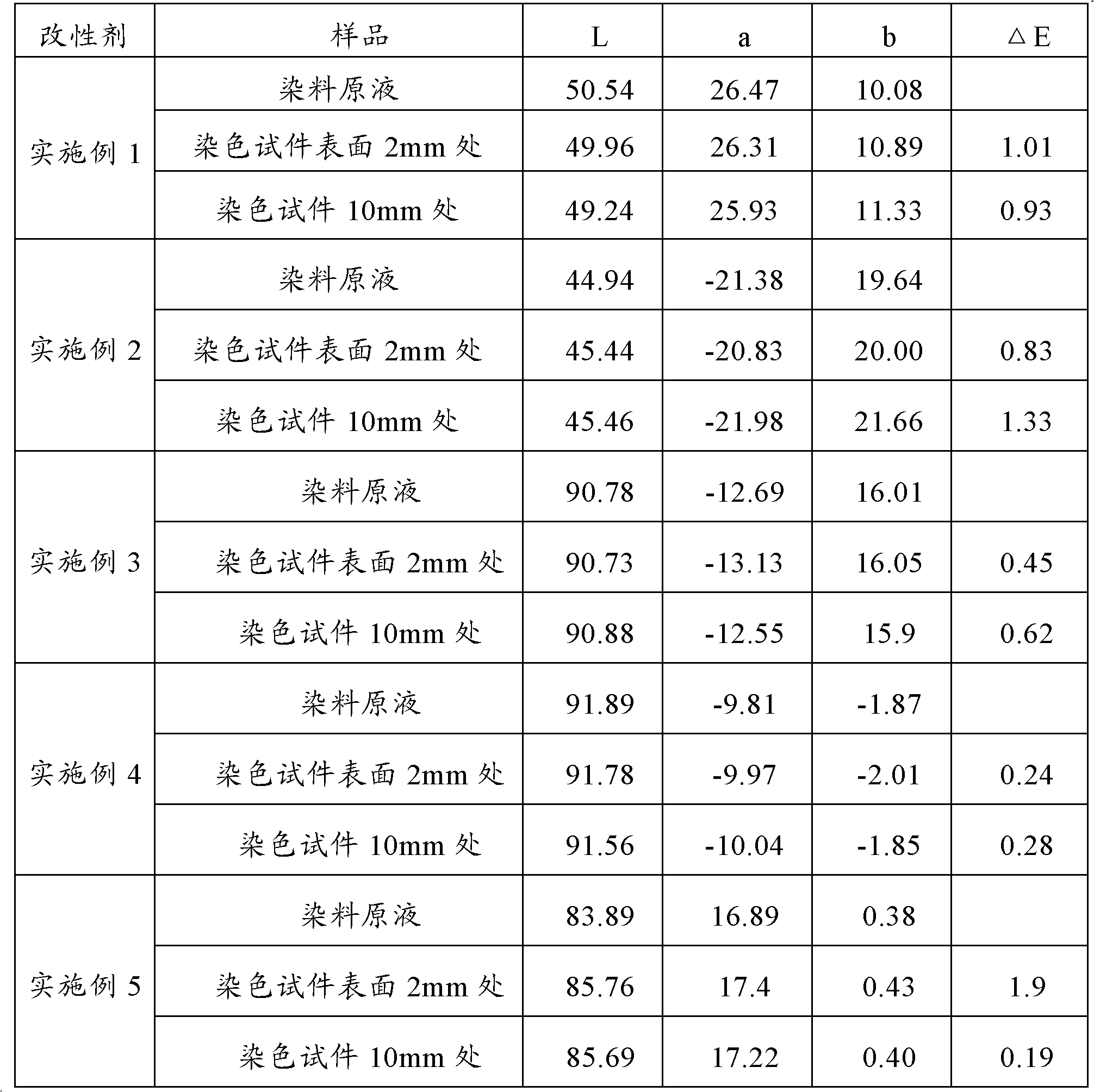Wood dyeing modifier and preparation method thereof
A modifier, wood technology, applied in the direction of coating, etc., can solve the problems of modifiers such as dimensional stability, little increase in hardness, dye colorability, poor light resistance, single function, etc.
- Summary
- Abstract
- Description
- Claims
- Application Information
AI Technical Summary
Problems solved by technology
Method used
Image
Examples
Embodiment 1
[0019] Accurately weigh the following weights of the raw material components:
[0020] Mass concentration is 200g of formaldehyde aqueous solution of 35%, phenol 50g, urea 300g, melamine 50g, ammoniacal liquor (mass concentration is 20%) 20g, sodium carbonate 1g, ammonium chloride 10g, bulking agent 50g (wherein cornstarch 5g, chlorinated Sodium 45g), acid dye (selected from the composition of acid black N-GRS, acid yellow G, acid red GR of Foshan Nanhai District Ligang Dyeing Co., Ltd., the ratio between each dye can be adjusted arbitrarily according to the required color ) 1g.
[0021] Add formaldehyde solution to the reaction kettle, adjust the pH to 7.0 with sodium carbonate solution, add urea, then raise the temperature to 60°C and react for 2 hours; adjust the pH to 6.5, add phenol and ammonia water, heat up to 70-80°C and react for 30-35 Minutes; use sodium carbonate solution to adjust the pH to 8.0, add melamine and sodium carbonate, after the melamine is completely d...
Embodiment 2
[0023] Accurately weigh the following weights of the raw material components:
[0024]Mass concentration is 200g of formaldehyde aqueous solution of 35%, phenol 60g, urea 300g, melamine 50g, ammonia water (mass concentration is 30%) 30g, potassium carbonate 10g, magnesium chloride 30g, bulking agent 70g (wherein cornstarch 30g, calcium chloride 20g ), acid dye 1g (selected from the composition of Acid Black N-GRS, Acid Yellow G, and Acid Red GR from Foshan Nanhai District Ligang Dyeing Co., Ltd., the ratio of each dye can be adjusted arbitrarily according to the desired color) .
[0025] Add formaldehyde to the reaction kettle, adjust the pH to 8.5 with sodium carbonate solution, add urea, and then raise the temperature to 70°C for 3 hours; adjust the pH to 8.5, add phenol and ammonia water, heat up to 80°C for 35 minutes; use sodium carbonate Adjust the pH of the solution to 8.0, add melamine and potassium carbonate, after the melamine is completely dissolved, keep it warm a...
Embodiment 3
[0027] Accurately weigh the following weights of the raw material components:
[0028] Mass concentration is 200g of formaldehyde aqueous solution of 40%, phenol 80g, urea 370g, melamine 80g, ammoniacal liquor (mass concentration is 25%) 20g, sodium hydroxide 1g, calcium chloride 15g, bulking agent 60g (wherein tapioca starch 30g, magnesium chloride 30g), acid dye 1g (selected from the composition of Acid Black N-GRS, Acid Yellow G, and Acid Red GR from Foshan Nanhai District Ligang Dyeing and Chemical Co., Ltd., the ratio of each dye can be adjusted arbitrarily according to the desired color ).
[0029] Add formaldehyde solution to the reaction kettle, adjust the pH to 7.5 with sodium carbonate solution, add urea, and then heat up to 65°C for 2.5 hours; adjust the pH to 7.0, add phenol and ammonia water, heat up to 75°C for 30 minutes; Sodium solution to adjust the pH to 8.0, add melamine and sodium hydroxide, after the melamine is completely dissolved, keep warm at 75°C for...
PUM
 Login to View More
Login to View More Abstract
Description
Claims
Application Information
 Login to View More
Login to View More - R&D
- Intellectual Property
- Life Sciences
- Materials
- Tech Scout
- Unparalleled Data Quality
- Higher Quality Content
- 60% Fewer Hallucinations
Browse by: Latest US Patents, China's latest patents, Technical Efficacy Thesaurus, Application Domain, Technology Topic, Popular Technical Reports.
© 2025 PatSnap. All rights reserved.Legal|Privacy policy|Modern Slavery Act Transparency Statement|Sitemap|About US| Contact US: help@patsnap.com



